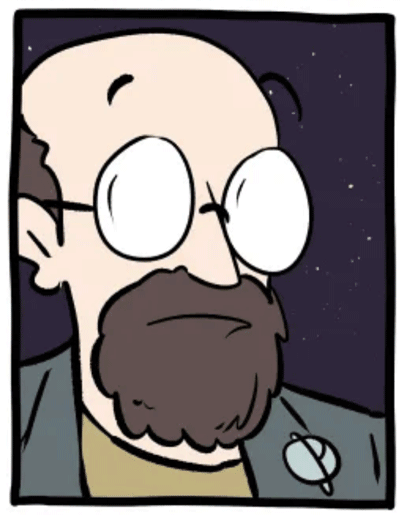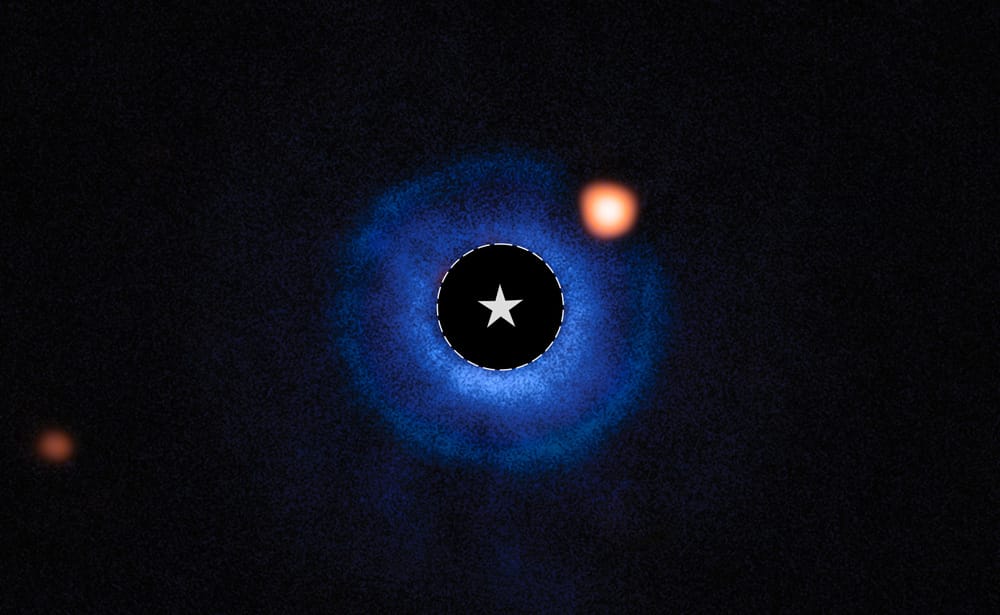- Bad Astronomy Newsletter
- Posts
- JWST spies a Saturn-sized planet from a quadrillion kilometers away
JWST spies a Saturn-sized planet from a quadrillion kilometers away
The exoplanet orbits a red dwarf and is the lowest mass one ever directly spotted
July 1, 2025 Issue #899
Hey you! Don’t forget about the discounted subscription sale!
I’m offering 20% off subscription rates for this newsletter, which means you pay only $4.80/month or $48/year. I have more info in Issue 898. Please check it out and sign up!
Note: This issue, being on a Tuesday, is usually only sent to paid subscribers but this is a preview of what you’ll get (there’s a paywall but you’ll see most of the article).
SMBC and me
I should put these on my CV
[Note: This is, ah, somewhat of an adult topic, so if that sort of thing isn’t your sort of thing you might just want to skip to the next section.]
I am always amused and flattered when my friend Zach Weinersmith puts me into one of his Saturday Morning Breakfast Cereal comics, but why are they always about aliens, or sex, or alien sex? Pro tip: if you see an astronomer in SMBC, you can tell it’s me because Zach always draws me with a button that has a p and a Φ on it, representing my name.

Mmmmm, cartoony. Credit: Zach Weinersmith
Also, did you know that a) when you hover over the comic (or tap it on a mobile device) you get another punchline, and 2) if you click the red button below the comic you get a bonus panel?
Click the red button now, because I have a follow-up joke!
When I clicked the red button on this comic, I immediately texted Zach, saying, “I think the Klingons were more into cloacking devices.
JWST directly sees a low(ish)-mass planet orbiting a nearby star
It’s the lowest mass planet found to cause gaps in a protoplanetary disk
Regular BANners know that the most successful way we have to discover exoplanets — alien worlds orbiting alien stars — is the transit method, where we see a mini-eclipse when the planet passes in front of its star.
Another successful method is direct imaging: literally, seeing a planet in an image. Like, there’s a dot of light next to the star. This method is tricky, though, for lots of reasons. Planets are faint and stars bright, so you need a way to block the vast majority of the star’s light to see the planet. Planets tend to be every close to their star, so you also need exceptional resolution (and, in general, an exoplanetary system that’s relatively close to Earth so that the apparent distance between them is maximized).
One big advantage is that when they’re young, planets are very hot (imagine a million asteroids impacting Earth every day; we’d get hot too). That means they glow in the infrared. Stars don’t tend to be bright in the IR, so if you look in that part of the spectrum it gives you a boost.
Enter JWST. The monster space observatory has keen vision, looks in the infrared, and has filters equipped with coronagraphs, small metal disks that can block the starlight to let you see faint objects nearby. Even better, one of these filters lets through light at a wavelength of 11.4 microns, which is in the thermal infrared where hot planets will emit light the best.
The star TWA 7 (or CE Antliae) is a low-mass dim bulb of a red dwarf just 111 light-years from Earth. It’s young, just over 6 million years old, and surrounded by what’s called a debris disk. When it first forms, the star is circled by a disk of gas and dust that can coalesce into small pieces of rock called planetesimals. These collide and create a disk of debris, and it’s this that eventually forms planets. So it’s a good place to look for them.
We see the disk face-on, and there’s structure in it too, including three rings of material that could be forming planets. Not only that, but in one of the rings there’s a chunk missing, a cavity that could be hiding a planet invisible to other telescopes.
So astronomers pointed JWST at TWA 7, put the star behind the coronagraph, and took images.
And what did they see? BOOM! Planet.

The blue material is the debris disk, and the orange blob the purported planet. Credit: NASA, ESA, CSA, Anne-Marie Lagrange (CNRS, UGA), Mahdi Zamani (ESA/Webb)
Coooool. The material colored blue in the image is the debris disk as seen by the ESO Very Large Telescope (or VLT). The orange blob is the planet, called TWA 7b, seen by JWST superposed on the VLT image. The black inner region is where the star has been blocked, and the star shape marks its position (the other blob to the left is a background galaxy).
Planets cool as they age, and the more massive they are the longer they stay hotter. Using that, the astronomers estimate TWA 7b has about 0.3 times the mass of Jupiter, right around the same mass as Saturn. It orbits the star about 52 times farther out than Earth orbits the Sun, or nearly 8 billion kilometers (for comparison, Neptune is about 3.5 billion out from the Sun). So it’s pretty far out.

Subscribe to Premium to read the rest.
Become a paying subscriber of Premium to get access to this post and other subscriber-only content.
Already a paying subscriber? Sign In.
A subscription gets you:
- • Three (3!) issues per week, not just one
- • Full access to the BAN archives
- • Leave comment on articles (ask questions, talk to other subscribers, etc.)


Reply